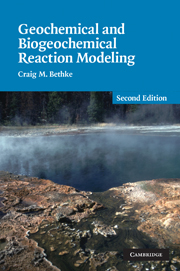Book contents
- Frontmatter
- Contents
- Preface
- Preface to first edition
- A note about software
- 1 Introduction
- 2 Modeling overview
- Part I Equilibrium in natural waters
- 3 The equilibrium state
- 4 Solving for the equilibrium state
- 5 Changing the basis
- 6 Equilibrium models of natural waters
- 7 Redox disequilibrium
- 8 Activity coefficients
- 9 Sorption and ion exchange
- 10 Surface complexation
- 11 Automatic reaction balancing
- 12 Uniqueness
- Part II Reaction processes
- Part III Applied reaction modeling
- Appendix 1 Sources of modeling software
- Appendix 2 Evaluating the HMW activity model
- Appendix 3 Minerals in the LLNL database
- Appendix 4 Nonlinear rate laws
- References
- Index
9 - Sorption and ion exchange
Published online by Cambridge University Press: 05 August 2012
- Frontmatter
- Contents
- Preface
- Preface to first edition
- A note about software
- 1 Introduction
- 2 Modeling overview
- Part I Equilibrium in natural waters
- 3 The equilibrium state
- 4 Solving for the equilibrium state
- 5 Changing the basis
- 6 Equilibrium models of natural waters
- 7 Redox disequilibrium
- 8 Activity coefficients
- 9 Sorption and ion exchange
- 10 Surface complexation
- 11 Automatic reaction balancing
- 12 Uniqueness
- Part II Reaction processes
- Part III Applied reaction modeling
- Appendix 1 Sources of modeling software
- Appendix 2 Evaluating the HMW activity model
- Appendix 3 Minerals in the LLNL database
- Appendix 4 Nonlinear rate laws
- References
- Index
Summary
An important consideration in constructing certain types of geochemical models, especially those applied to environmental problems, is to account for the sorption of aqueous species onto sediment surfaces (e.g., Zhu and Anderson, 2002). Because of their large surface areas and high reactivities (e.g., Davis and Kent, 1990), many components of a sediment – especially clay minerals, zeolites, metal oxides and oxyhydroxides, and organic matter – can sorb considerable masses.
Sorption can significantly diminish themobility of certain dissolved components in solution, especially those present in minor amounts. Sorption, for example, may retard the spread of radionuclides near a radioactive waste repository or the migration of contaminants away from a polluting landfill (see Chapters 21 and 32). In acid mine drainages, ferric oxide sorbs heavy metals from surface water, helping limit their downstream movement (see Chapter 31). A geochemical model useful in investigating such cases must provide an accurate assessment of the effects of surface reactions.
In this chapter, we consider several simple models of ion sorption and exchange that can be applied within the context of a geochemical model. These models include distribution coefficients, Freundlich and Langmuir isotherms, and ion exchange theory. In the following chapter (Chapter 10), we consider surface complexation theory, which is more complicated but in some ways more robust than the models presented here.
Distribution coefficient (Kd) approach
The distribution coefficient approach – commonly referred to as the Kdapproach – is the most widely applied method in environmental geochemistry for predicting the sorption of contaminant species onto sediments. The distribution coefficient Kd itself is simply the ratio under specific conditions of the sorbed to the dissolved mass of a contaminant.
- Type
- Chapter
- Information
- Geochemical and Biogeochemical Reaction Modeling , pp. 137 - 154Publisher: Cambridge University PressPrint publication year: 2007



